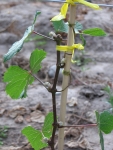3 zones for grape berry juice
Juice from a grape berry comes from three different zones. The composition of the juice is different in each zone. Working from the inside of the berry out towards the skin, the three zones are: central, intermediate and peripheral.
Crushing a berry (breaking open the skin) releases the free run juice. This is the sweetest juice, with the most nutrients and the least amount of harsh phenolics (tannins.) This juice comes from the intermediate zone …

 Question: How important is it to protect a red wine from oxygen during fermentation?
Question: How important is it to protect a red wine from oxygen during fermentation?





